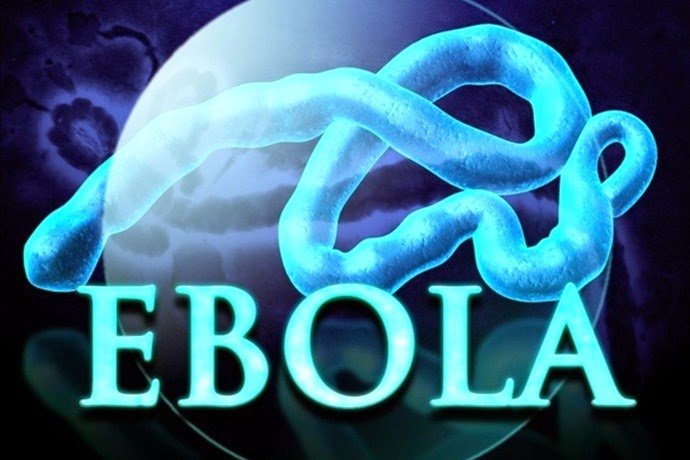
Ebola Virus Disease (EVD) is acute, serious illness lead to death, formerly known as Fatal Hemorrhagic Fever in humans and mammals, caused by genus Ebolavirus, family Filoviridae, and order Mononegavirale. It is negative sense single stranded RNA and disease is caused by Zaire ebolavirus. EVD is highly fatal disease and epidemic in South Africa, transmitted by wild animals and spread through humans to humans. It affects human and non human primates. EVD in human being is caused by four viruses belong to genus Ebola virus. These are viruses named as Bundibugyo, Sudan, Tai Forest, and Ebola virus. Zaire virus is most dangerous known EVD causing specie. Reston virus (RESTV), fifth virus of genus Ebolavirus cause disease in other primates. Ebola virus is closely related to Marburgvirus.
First time EVD known to be appeared in 1972 in two simultaneous outbreaks in regions named Nzara, Sudan and Yambukii, Congo, respectively. During 2013 to 2014, current outbreak is going on in West Africa. It is the most complex and largest outbreak, resulted in 19465 suspected cases and 7580 confirmed cases. Severely affected countries are Guninea, Sierra Leone, Congo, Liberia, Nigeria, Senegal having very weak health system, lacking human and infrastructure resources and poor health status.
Fruit bats are thought to be Ebola virus host naturally belong to family Pteropodidae. It is transmitted to human by wild animals. It spreads through direct contact with blood, body secretions like semen, urine, breast milk, tears, sweat, feces, vomit, mucus and saliva, contact with contaminated objects like needles, syringes. Hospital acquired transmission has also occur. No airborne transmission and insects are reported in transmission of Ebola virus.
Incubation period of Ebola virus is 2 to 21 days, to onset of symptoms. Humans are not considered as infected until they developed symptoms of disease. The sign and symptoms include fever, fatigue, muscle pain, nausea, headache, chest pain, sore throat and short breathing. In some cases bleeding occurs through both internal and external ways, oozing out of blood from gums, anus and other openings and then lead to death. Fever is usually higher than 100.9 °F followed by diarrhea, vomiting and maculopapular rash whilesymptoms of kidney and liver function also appeared. Liver inflammation, decreased hearing, continued weakness, decreased appetite and ongoing muscle and joint pain are symptoms after recovery of patient.
Laboratory test findings include decrease white blood cells (WBCS), platelet and increase amount of liver enzymes.Ebola virus is negative sense single stranded single stranded, non infectious RNA genome containing 7 genes which includes 3-UTR-NP-VP35-GP-VP30-VP24-L-5ULR. It only differs in sequence in the different Ebola virus species. Ebola virus is 80 nm wide and 14000 nm long.
EBOV replicates effectively in blood cell includes monocytes and macrophages while dendrites cells and some other including liver cells, adrenal gland cells and fibroblasts are also include in replication. Viral replication triggers the process of release of high level of inflammation which leads to septic state.
Diagnosis is done by the history, signs and symptoms of disease. Confirmed diagnosis by using Antibody captured Elisa, RT-PCR assay, Antigen captured detection test (ACDT), virus isolation by cell culture, electron microscopy and serum neutralization test.
Differentially diagnose from the Malaria, Typhoid fever, Cholera, Meningitis and Viral Hemorrhagic Fever and Dengue Fever in early stages. In later stages, EVD is differentiated from Rickettsial disease, Sepsis, Scrub typhus, Q fever, viral hepatitis, visceral leishmaniasis, Trypanosomiasis, Histoplasmosis and Candidiasis.
Yet not proven treatment or vaccination for EVD. Treatment is done for the specific symptoms and rehydration with oral and intra venous fluids as supportive care. No licensed vaccine till now but two potential vaccines is undergoing human safety testing.
Different protective measures and strategies are used to control disease including masks, gloves, gowns and goggles for infected persons. In addition infected persons should be isolate from healthy people. All equipments including patient waste, medical waste and surfaces in contact with infected fluids. Other strategies include available kits commercially to help families in homes include clothing and chlorine powder for prevention of disease. Ebola virus can be eliminated by boiling for 5 minutes or heating for 30-60 minutes. Lipid solvents like detergents calcium hypochlorite and alcohol based products are used to disinfect the infected surfaces. If infected person dies, direct contact with body can spread disease so body should be properlyburied. Proper procedure of isolation should be followed by transportation crews as per instructions given to them.
The authors are from the Department of Parasitology, Faculty of Veterinary Science, University of Agriculture, Faisalabad, Punjab, Pakistan. They can be reached at Khizerhayat46@yahoo.com